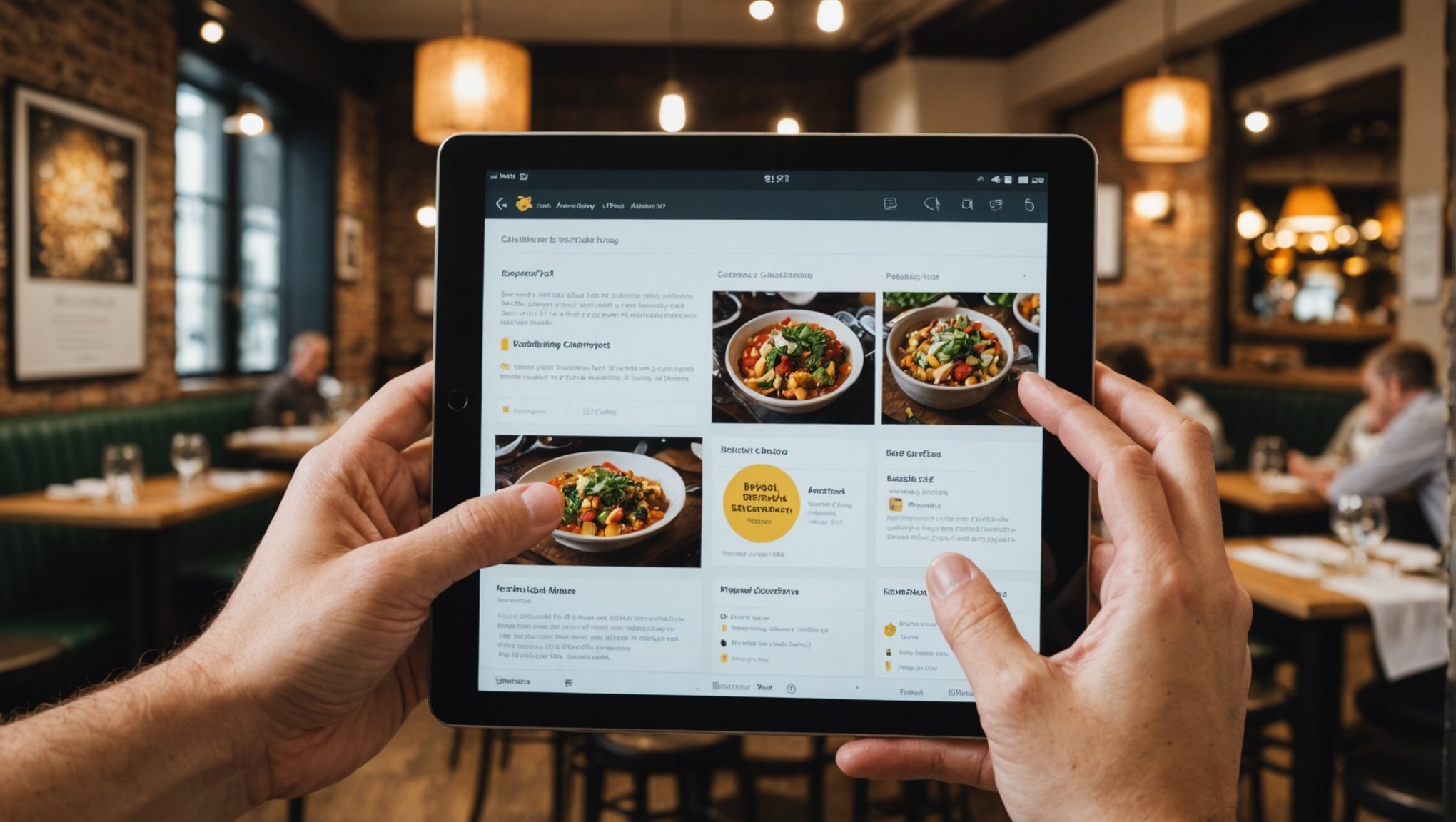Bristol's vibrant culinary scene is brimming with potential. Eateries can unlock new opportunities by harnessing the power of data analytics. From understanding customer preferences to optimizing ingredient sourcing, analytics offers insights that can elevate menu creation. Imagine tailoring dishes based on real-time feedback and enhancing customer experiences with personalized options. This approach not only boosts satisfaction but also drives profitability. Discover how data-driven decisions can transform Bristol's dining landscape and set local restaurants apart in a competitive market.
The Role of Data Analytics in the Culinary Industry
In today's fast-paced culinary world, data analytics is transforming how restaurants operate. By harnessing data, restaurants can make informed decisions that enhance customer experiences and improve operational efficiency.
In parallel : Elevating Property Marketing: Innovative Ways Bournemouth Real Estate Agencies Can Utilize Drone Technology
Data analytics in restaurants involves collecting and analysing information such as customer preferences, sales patterns, and ingredient costs. This information helps restaurateurs understand what dishes are popular and which ones might need adjustments. As a result, they can tailor their menus to better meet customer demands and optimise inventory management.
Current trends show that many restaurants are adopting advanced data analytics tools. These tools allow them to track customer feedback in real-time, monitor social media mentions, and even predict future food trends. By staying ahead of the curve, restaurants can maintain a competitive edge in a crowded market.
Topic to read : Unlocking Collaboration: Leveraging Open-Source Tools in a Cambridge Research Lab
The benefits of data-driven decision-making in menu development are substantial. Restaurants can experiment with new dishes based on data insights and identify which items to promote as specials. This approach reduces waste, increases profitability, and ensures that the menu resonates with diners.
By embracing data analytics, the culinary industry can continue to innovate, ensuring that restaurants not only survive but thrive in an ever-evolving landscape.
Case Studies of Bristol Eateries Employing Data Analytics
In the vibrant city of Bristol, several restaurants have embraced data analytics, showcasing its transformative power. These Bristol restaurant case studies offer compelling insights into how data can drive success in the culinary industry.
One standout example is a popular Bristol bistro that utilised data analytics to refine its menu. By analysing consumer data, the restaurant identified dishes that resonated most with diners, leading to strategic menu changes. This data-driven approach not only streamlined their offerings but also significantly boosted customer satisfaction and sales growth.
Another Bristol eatery focused on leveraging data to enhance customer experiences. By tracking feedback and preferences, they tailored their service to meet customer expectations better. This proactive use of data analytics resulted in a noticeable increase in repeat customers and positive reviews.
A third case study involves a restaurant that used data to optimise ingredient sourcing and reduce waste. By understanding consumption patterns, they adjusted their inventory processes, leading to cost savings and a more sustainable operation.
These examples illustrate the profound impact of data analytics on Bristol's dining scene. By harnessing the power of data, these restaurants have not only improved operational efficiency but also created a more personalised and satisfying dining experience for their patrons.
Practical Steps for Implementing Data Analytics in Restaurants
Implementing data analytics in restaurants can revolutionise operations and customer satisfaction. To begin, it's crucial to identify key data points that will enhance your menu. Focus on customer preferences, sales trends, and ingredient costs to tailor offerings effectively. This data-driven approach ensures that your menu aligns with diner expectations while optimising inventory.
Next, consider the tools and software available for data analysis in restaurants. Solutions like POS systems, customer feedback platforms, and inventory management software are invaluable. These tools provide real-time insights, enabling restaurateurs to make informed decisions quickly. Investing in a comprehensive analytics platform can streamline data collection and analysis, offering a unified view of your restaurant's performance.
Training staff to utilise data analytics is essential for successful implementation. Equip your team with the knowledge and skills to interpret data insights and apply them to daily operations. Workshops, online courses, and hands-on training sessions can be effective methods. By fostering a data-centric culture, employees become more engaged and proactive in enhancing customer experiences.
Incorporating data analytics into your restaurant's strategy not only boosts efficiency but also positions your establishment as a leader in the culinary industry.
Analyzing Consumer Preferences in Bristol
Understanding consumer preferences is pivotal for Bristol's restaurants aiming to stay competitive. To effectively gather consumer feedback, eateries employ various methods such as surveys, comment cards, and digital platforms. These tools offer direct insights into diner satisfaction and preferences.
Local dining trends play a crucial role in consumer preferences analysis. By examining what dishes are gaining popularity, restaurants can tailor their offerings to align with current tastes. This not only enhances customer satisfaction but also ensures that the menu remains relevant and enticing.
Consumer insights, derived from detailed analysis, can significantly shape menu offerings. By understanding what customers enjoy, restaurants can introduce new dishes or modify existing ones to better meet expectations. This data-driven approach helps in identifying potential menu items that could become customer favourites, ultimately boosting sales and loyalty.
Moreover, leveraging technology such as social media monitoring and online review platforms provides real-time feedback, allowing restaurants to adapt quickly. This proactive strategy ensures that Bristol eateries can respond to changing consumer preferences efficiently, creating a more personalised dining experience. By prioritising consumer preferences analysis, restaurants can maintain a dynamic menu that resonates with their audience.
Benefits of Data-Driven Menu Development
In the culinary industry, data-driven menus are revolutionising how restaurants craft their offerings. By leveraging data analytics, eateries can significantly enhance the customer experience through more personalised menus. This approach allows chefs to tailor dishes to diners' preferences, ensuring satisfaction and encouraging repeat visits.
Optimising ingredient sourcing is another major advantage of data-driven menu development. By analysing consumption patterns, restaurants can efficiently manage their inventory, reducing waste and ensuring fresh supplies. This not only supports sustainability but also maintains the quality of dishes served.
Furthermore, informed menu pricing plays a crucial role in boosting profitability. By understanding which dishes are popular and which ingredients are cost-effective, restaurants can strategically price their offerings. This data-informed approach ensures competitive pricing while maximising revenue.
- Enhancing customer experience: Personalised menus cater to individual tastes.
- Optimising ingredient sourcing: Efficient inventory management reduces waste.
- Increasing profitability: Strategic pricing enhances revenue.
By focusing on these aspects, restaurants can create menus that resonate with their clientele, streamline operations, and improve their bottom line. Embracing data-driven strategies in menu development not only meets current market demands but also positions eateries for long-term success.
Tools for Data Analytics in the Culinary Sector
In the competitive restaurant industry, the right data analytics tools can make a significant difference in operations and customer satisfaction. Popular tools in this domain include Point of Sale (POS) systems, which track sales and inventory, and customer feedback platforms, which gather insights into diner preferences. These tools offer real-time data, essential for making informed decisions.
When selecting data analytics software, it's crucial to consider features like user-friendliness, integration capabilities with existing systems, and the ability to provide comprehensive reports. Look for software that can handle large data volumes and offers predictive analytics to foresee trends and customer behaviour.
In Bristol, several eateries have successfully implemented these tools. For instance, a local café utilised advanced POS systems to streamline their inventory management, reducing waste and improving profitability. Another restaurant adopted customer feedback platforms, enabling them to personalise the dining experience based on real-time customer insights.
By leveraging these data analytics tools, restaurants not only enhance operational efficiency but also create a more tailored and engaging dining experience. Investing in the right software can position eateries as leaders in the culinary sector, ensuring they remain competitive and responsive to customer needs.
Challenges in Leveraging Data Analytics
Adopting data analytics in restaurants is not without its hurdles. Many establishments face significant challenges in restaurant analytics, primarily due to the complexity of integrating new technologies with existing systems. Compatibility issues often arise, making it difficult for restaurants to fully utilise the potential of analytics tools.
Another common obstacle is the lack of expertise. Many restaurant staff members may not be familiar with data analytics, leading to a steep learning curve. This gap can hinder the effective implementation and utilisation of data-driven strategies, impacting overall efficiency and decision-making.
To overcome these challenges, restaurants should invest in ongoing training and support. Providing staff with regular workshops and access to online courses can enhance their understanding and ability to leverage analytics effectively. Additionally, seeking partnerships with tech companies for tailored solutions can ease integration issues.
Furthermore, establishing a dedicated team or hiring a data analyst can ensure that insights are accurately interpreted and applied. This approach not only mitigates the challenges but also maximises the benefits of data analytics. By addressing these obstacles head-on, restaurants can harness the full potential of data analytics, leading to improved operational efficiency and customer satisfaction.
Expert Insights on Data Analytics in the Culinary World
In the ever-evolving culinary industry, expert opinions on restaurant data analytics reveal transformative potential. Industry leaders emphasize the importance of data in understanding consumer preferences and optimizing operations. Renowned chef Jamie Oliver notes, "Data allows us to tailor our offerings precisely to what diners crave, enhancing their experience."
Collaboration between chefs and data analysts is crucial. Chef Heston Blumenthal highlights that understanding data helps chefs innovate while maintaining authenticity. He states, "When chefs work alongside data analysts, they can experiment with new dishes confidently, knowing there's a solid foundation of customer insights."
Looking ahead, experts predict that future trends in data analytics for restaurants will focus on real-time feedback and predictive analytics. This will enable restaurants to adapt swiftly to changing consumer preferences. Data scientist Sarah Thompson suggests, "The next frontier is using AI to predict food trends, allowing restaurants to stay ahead of the curve."
- Quotes and insights from industry experts underscore the necessity of data in modern dining.
- Collaboration between chefs and data analysts fosters innovation and precision.
- Future trends will likely include AI-driven predictions, revolutionizing menu development.
By embracing these insights, the culinary world can leverage data analytics to enhance customer satisfaction and operational efficiency.
Tailoring Menus to Local Trends and Preferences
In the bustling culinary scene of Bristol, understanding local dining trends is essential for restaurants aiming to stay relevant and competitive. By identifying these trends, eateries can craft menus that resonate with the tastes and preferences of their local clientele.
One approach to identifying key local dining trends is through the analysis of customer feedback and social media interactions. This data reveals what dishes are gaining popularity and provides insights into evolving taste preferences. For instance, there has been a noticeable shift towards plant-based options, with many diners seeking healthier and more sustainable choices.
Adapting menus to meet these local tastes involves incorporating popular ingredients and dishes that reflect current trends. Restaurants that successfully adapt often see increased patronage and customer satisfaction. An example is a Bristol café that introduced a range of vegan options, aligning with the growing demand for plant-based meals. This strategic adaptation not only attracted a broader customer base but also enhanced their reputation as a forward-thinking establishment.
By continuously monitoring local dining trends and adapting menus accordingly, restaurants can ensure they meet the dynamic preferences of their patrons, fostering loyalty and driving business success.
Future of Data Analytics in Bristol's Culinary Scene
As we look to the future of restaurant analytics, predictions indicate a revolution in how Bristol's culinary scene will evolve. Advanced analytics will play a crucial role in redefining menu innovation and customer engagement. By leveraging cutting-edge technology, restaurants will be able to anticipate diner preferences with remarkable accuracy.
The future holds the promise of AI-driven insights, enabling eateries to not only track but predict trends before they become mainstream. This proactive approach will allow chefs to experiment with new dishes, confident in their alignment with customer desires. Such innovation will likely lead to more dynamic and personalised menus, enhancing the overall dining experience.
Moreover, the integration of smart technology will transform customer engagement. Interactive menus, augmented reality experiences, and personalised recommendations based on past dining history are just a few examples of how technology will shape the future of dining in Bristol. These advancements will create a more immersive and tailored experience for diners.
By embracing the future of restaurant analytics, Bristol's culinary establishments can stay ahead of the curve, ensuring they remain competitive and relevant in a rapidly changing industry. As technology continues to advance, the possibilities for innovation in the dining experience are endless.











